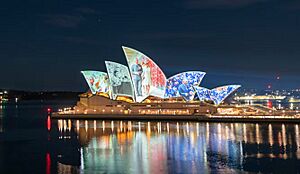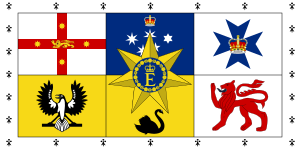Monarchy of Australia facts for kids
Quick facts for kids King of Australia |
|
|---|---|
|
Federal
|
|

|
|
| Incumbent | |
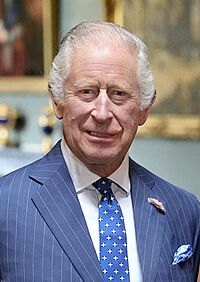 |
|
| Charles III since 8 September 2022 |
|
| Details | |
| Style | His Majesty |
| Heir apparent | William, Prince of Wales |
The monarchy of Australia is a key component of Australia's form of government, by which a hereditary monarch serves as the country's sovereign and head of state. It is a constitutional monarchy, modelled on the Westminster system of parliamentary democracy, while incorporating features unique to the constitution of Australia.
The present monarch is King Charles III, who has reigned since 8 September 2022. The monarch is represented at the federal level by the governor-general (currently Samantha Mostyn), in accordance with the Australian constitution and letters patent from his mother and predecessor, Queen Elizabeth II. Similarly, in each of the Australian states the monarch is represented by a governor (assisted by a lieutenant-governor; generally the Chief Justice of the state's supreme court), according to the Australia Act and respective letters-patent and state constitutions. The monarch appoints the governor-general on the advice of the prime minister and the state governors on the advice of the respective premiers. These are the only mandatory constitutional functions of the monarch of Australia.
Australian constitutional law provides that the person who is monarch of the United Kingdom will also be the monarch of Australia. Since the 1940s at the latest, the Australian monarchy has been a distinct office and in that capacity, they act exclusively upon the advice of Australian state and federal ministers. Australia is one of the Commonwealth realms, 15 independent countries that share the same person as monarch and head of state.
Contents
International and domestic aspects
The monarch of Australia is the same person as the monarch of the 14 other Commonwealth realms within the 56-member Commonwealth of Nations. However, each realm is independent of the others, the monarchy in each being distinct from the rest. Effective with the Australia Act 1986, the British government cannot advise the monarch on any matters pertinent to Australia; on all matters of the Australian Commonwealth, the monarch is advised solely by Australian federal ministers of state. Likewise, on all matters relating to any Australian state, the monarch is advised by the ministers of that state, tendered via the premier.
Emergence of a separate Crown
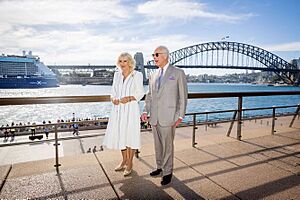
Courts and academics have proposed several dates on which the Crown of Australia separated from the Crown of the United Kingdom. These include 1926, when at an Imperial Conference it was announced that governors-general would no longer represent the government of the United Kingdom or 1930, when at another Imperial Conference it was clarified that the monarch would be advised directly by dominion ministers. Anne Twomey argues for this later date at the latest. Others have suggested the Crowns separated once Australia became fully independent, with dates suggested including 1931 (when the UK Statute of Westminster was passed), 1939 or 1942 (due to Statute of Westminster Adoption Act, passed in 1942 with retrospective effect to 1939) or 1986 (when the Australia Acts severed the last possibilities of UK institutions changing Australian laws). However, members of the High Court have indicated that the separation of the Crowns was complete by at least 1948, as seen by the creation of Australian citizenship laws.
It is unclear however whether for each state there is also a distinct Crown, separate from the Crown of Australia. In other words, the monarch may also be king of Victoria, etc. for each of the states. Prior to the passage of the Australia Act, the monarch acted as sovereign of the United Kingdom at the state level. With that Act's passage, either independent Crowns emerged for each of the states or the Crown of Australia transformed into a federal Crown in which the monarch receives advice from both state and commonwealth ministers in exercising their respective powers. Such a distinction may be relevant if either Australia or an individual state wished to become a republic, as with separate crowns, a federal republic would not necessarily abolish the Crown at a state level.
Title
The formal title of the current monarch is King Charles the Third, by the Grace of God King of Australia and His other Realms and Territories, Head of the Commonwealth.
Prior to 1953, the title of the Australian monarch had simply been the same as that in the United Kingdom. A change in the title resulted from occasional discussion among Commonwealth prime ministers and an eventual meeting in London in December 1952, at which Australia's officials stated their preference for a format for Queen Elizabeth II's title that would name all the realms. However, they stated they would also accept Elizabeth II (by the Grace of God) of the United Kingdom of Great Britain and Northern Ireland, [name of realm], and all of her other Realms and Territories Queen, Head of the Commonwealth (Defender of the Faith). The latter composition was adopted, despite some objections from the South African and Canadian governments. The sovereign's title in all her realms thus kept mention of the United Kingdom, but, for the first time, also separately mentioned Australia and the other Commonwealth realms. The passage of the Royal Style and Titles Act 1953 by the Parliament of Australia put these recommendations into law.
In 1973 the Whitlam government replaced the 1953 royal styles Act, with Whitlam arguing that the inclusion and position of Elizabeth's title in the UK made the title not "sufficiently distinctively Australian" and that the phrase "Defender of the Faith" had "no historical or constitutional relevance in Australia". A new Royal Titles and Styles Bill that removed these references was passed by the federal Parliament. The governor-general, Sir Paul Hasluck, reserved royal assent for the monarch, as governor-general Sir William McKell had done with the 1953 Royal Titles and Styles Bill to allow Elizabeth to give her assent in person, which she did at Government House in Canberra on 19 October 1973.
At the state level, Western Australia and South Australia have independently legislated the monarch's title to be the same as the Commonwealth title. There is limited reference to the monarch's title in the other states, however parliamentarians have used expressions such as "Queen of [state]" and "Queen in right of [state]" during parliamentary debates. In 1973, Queensland sought to pass legislation to include Queensland specifically in the monarch's title. The Queensland parliament passed legislation seeking an advisory opinion from the Privy Council as to whether they had the legislative power to do, however this legislation was declared unconstitutional by the High Court. In seeking this title, the Queensland government's motivation was to dissuade the British from accepting the Whitlam government's advice that all of the British government's then authority over the states should be transferred to the federal government. The dismissal of the Whitlam government in 1975 removed the impetus for the title change and no further steps were taken in the matter.
On the accession of King Charles III, all the states apart from Victoria proclaimed the King's title to be the same as that proclaimed at the federal level. Victoria declared the monarch's title to be His Majesty King Charles the Third, by the Grace of God King of Australia and His other Realms and Territories, Head of the Commonwealth. However, subsequent Victorian government documents have used the title Charles the Third, by the Grace of God King of Australia and His other Realms and Territories, Head of the Commonwealth.
Succession
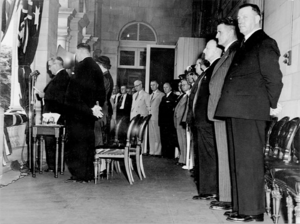
Royal succession is determined by a mix of common law, British law that continues to apply in Australia, and more recent Australian federal and state statutes. These entail that succession follows the eldest non-adopted child of the current monarch (primogeniture), with the restriction that an heir must be in communion with the Church of England and not a Roman Catholic to ascend the throne.
History
These rules have evolved over centuries. The British statutes, the Bill of Rights 1689 and the Act of Settlement 1701 first limited succession to legitimate descendants of Sophia, Electress of Hanover and imposed religious requirements in the context of the Glorious Revolution. These laws were received alongside all other British laws to Australia when Australia was settled. Considering the colonial status of the individual colonies and later the federated Australia, it was accepted at the time that these laws could only be changed by the UK Parliament.
Later, Australia and the other dominions gained greater legislative independence with the passage of the Statute of Westminster 1931 (adopted by Australia in 1939). While this allowed the dominions to pass laws that conflicted with UK laws, to ensure that succession laws remained consistent, the preamble noted that it would be in keeping with each Commonwealth realm's constitutional practice that any succession changes would require the consent of the parliaments of each realm.
As Australia had not yet adopted the Statute of Westminster by the time of the abdication of Edward VIII in 1936, the UK Declaration of Abdication Act 1936 applied automatically without the need for Australia's consent. However, the Australian federal Parliament did pass a resolution of assent to the changes as a matter of courtesy.
The most recent reforms to the succession occurred following the Perth Agreement in 2011, in which all the Commonwealth realms agreed to changes including the removal of a preference towards male heirs and the repeal of the Royal Marriages Act 1772 (which amongst other things prevented the monarch from marrying a Roman Catholic). As the Australian federal Parliament does not have a head of power over succession, it required a referral legislation from each of the states. The Northern Territory also added its request and concurrence, although this was not constitutionally required. The federal legislation finally become law on 24 March 2015 and as Australia was the last realm to the make the required changes, the act took effect on 26 March 2015 (BST), parallel to other realms' laws.
Demise of the Crown
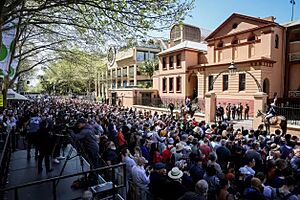
Upon a demise of the Crown (the death or abdication of a sovereign), it is customary for the accession of the new monarch to be publicly proclaimed by the governor-general on behalf of the Federal Executive Council, which meets at Government House after the accession. Parallel proclamations are made by the governors in each state. Regardless of any proclamations, the late sovereign's heir immediately and automatically succeeds, without any need for confirmation or further ceremony. Following an appropriate period of mourning, the monarch is also crowned at a coronation ceremony in the United Kingdom; though, this is not necessary for a sovereign to reign, being primarily a symbolic event. For example, Edward VIII was never crowned, yet was undoubtedly king during his short time on the throne. After an individual ascends the throne, he or she typically continues to reign until death.
The monarch legally cannot unilaterally abdicate; the only Australian monarch to do so, Edward VIII, did so following the passage of British legislation. While the UK has passed regency acts from 1936 onwards to prepare for a situation when the monarch is incapacitated, the dominions did not agree for these acts to be extended into domestic law as it was felt that governors-general could exercise all the powers a regent would need to exercise.
Finances
Australia does not fund the King or wider royal family for any activities taken outside of Australia, either towards personal income or to support royal residences outside of Australia. When monarch visits Australia, their expenses are paid for by the Australian Government. However, the Australian Government does pay a salary to the governor-general and for the upkeep of the official vice-regal residences in the country.
In 2018, a day-long visit to Vanuatu by Charles (then the Prince of Wales), escorted by Australian Minister for Foreign Affairs, Julie Bishop, in between a tour of Queensland and the Northern Territory, was paid for by the Australian government. Charles III's 2024 Australian royal tour cost $640,000, Elizabeth II's 2011 royal tour $2,690,000 and her 2006 tour $1,450,000.
Residences
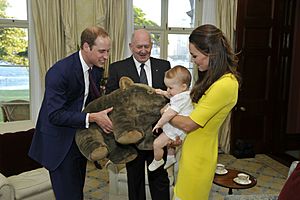
The governor-general has two official residences: Government House in Canberra (commonly known as Yarralumla) and Admiralty House in Sydney.
When HMY Britannia was in Australian waters and in use by the monarch of Australia, it was not available to British officials for meetings or promotions.
Personification of the state
The monarch is the locus of many oaths of allegiance. Various employees of the Crown are required by law to recite this oath before taking their posts, such as all members of the Commonwealth Parliament and of the state and territory parliaments, as well as most magistrates, judges, police officers, and justices of the peace. This is in reciprocation to the sovereign's coronation oath, taken most recently by Charles III who promised "to govern the Peoples of the United Kingdom of Great Britain and Northern Ireland [and] your other Realms ... according to their respective laws and customs".

The prime minister, ministers and parliamentary secretaries also make an oath or affirmation of office on their appointment to a particular ministry, which traditionally included a promise of allegiance to the monarch. However, the wording of this oath or affirmation is not written into law and beginning with swearing in of Paul Keating, all Labor prime ministers have dropped the reference to the sovereign.
The oath of citizenship similarly contained a statement of allegiance to the reigning monarch until 1994, when a pledge of allegiance to Australia and its values was introduced. However, the importance of allegiance to the monarch has been stressed by several justices in the context of determining whether a person is an "alien" for the purposes of section 51 the Constitution. For example, Justice Callinan held in Re Minister for Immigration and Multicultural Affairs; Ex parte Te (2002) that "judged from a constitutional — rather than a statutory — perspective, the fundamental criterion of membership [of the Australian body-politic] is allegiance to the Queen of Australia". However, the precise relationship and relative importance of constitutional and statutory definitions of "the people" is the subject of evolving interpretations of the court.
Head of state
Key features of Australia's system of government include its basis on a combination of written and unwritten rules, comprising the sovereign, governors, and governor-general. The Constitution does not mention the term head of state. According to the Parliament of Australia website, Australia's head of state is the monarch and its head of government is the prime minister, with powers limited by both law and convention for government to be carried on democratically. However, the governor-general's website states that the office holder is in practice Australia's head of state. A leading textbook on Australian constitutional law formulates the position thus: "The Queen, as represented in Australia by the governor-general, is Australia's head of state."
Additionally, Queensland and South Australia describe the monarch as the head of state for their particular state. New South Wales and Western Australia on the other hand describe their governors as their respective heads of state, whilst Tasmania and Victoria state that the governor "exercises the constitutional power" of the head of state.
While current official sources use the description head of state for the monarch, in the lead up to the referendum on Australia becoming a republic in 1999, Sir David Smith proposed an alternative explanation that the governor-general is head of state. This view has some support within the group Australians for Constitutional Monarchy.
Constitutional role and royal prerogative
Australia has a written constitution based on the Westminster model of government, implementing a federal system and a distinct separation of powers. It gives Australia a parliamentary system of government, wherein the role of the sovereign and governor-general is both legal and practical. The sovereign of Australia is represented in the federal sphere by the governor-general—appointed by the monarch on the advice of the prime minister of Australia—and in each state by a governor—appointed by the monarch upon the advice of the relevant state premier.
Executive
The only role the monarch must perform personally is appoint the governor-general. Additionally, assent for a bill may be reserved for the pleasure of the monarch, allowing them to exercise their judgement on whether to give assent. The monarch has also been personally involved in issuing letters-patent for the creation of Australian honours.
One of the main duties of the governor-general is to appoint the prime minister. This is, in accordance with convention, the individual with or most likely to obtain the confidence of the House of Representatives. This is usually the leader of the political party with a majority in that house or the head of a minority party that has secured supply and confidence arrangements with enough cross-benchers or other parties to reach majority support. The only time a prime minister was appointed without the majority support of the House of Representatives occurred before the first election in 1901 and during the 1975 constitutional crisis.
The governor-general also, on the advice of the prime minister, appoints the other ministers of state, a subset of which form the Cabinet. In accordance with the principles of responsible government, these ministers are, in turn, accountable to the Parliament and, through it, to the people. The monarch is informed by the governor-general of the acceptance of the resignation of a prime minister and the swearing-in of a new prime minister and other members of the ministry and the monarch holds audience with Australian ministers where possible.

The prime minister and the Federal Executive Council (which implements decisions of Cabinet) advises the governor-general on how to execute his or her executive powers over all aspects of government operations and foreign affairs. This means ministers direct the use of the royal prerogative that resides in the monarch, which includes the privilege to declare war, maintain peace, direct the actions of the Australian Defence Force, and negotiate and ratify treaties, alliances, and international agreements. The governor-general is empowered by the constitution to summon and prorogue parliament and call elections. Use of the royal prerogative does not require parliamentary approval.
As such, the monarch's and the governor-general's roles are primarily symbolic and cultural, acting as a symbol of the legal authority under which all governments and agencies operate. Still, the royal prerogative belongs to the Crown, not to any of the ministers, and the governor-general may unilaterally use these powers in exceptional situations, such as when, during the constitutional crisis in 1975, Sir John Kerr dismissed prime minister Gough Whitlam, on the occasion of a stalemate over government funding between the House of Representatives and the Senate.
Members of various executive agencies and other officials are appointed by the governor-general, including High Court judges. Ministers and parliamentary secretaries are also appointed to the Federal Executive Council. Royal commissions, a powerful type of public inquiry, are also commissioned by the Crown through a royal warrant.
Parliament
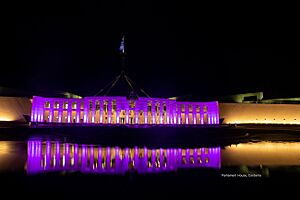
Parliament consists of the sovereign, the Senate and the House of Representatives. Their authority in the House of Representatives is represented by the Mace of the House (which also represents the authority of the house itself and its Speaker). However, neither the sovereign nor the governor-general participate in the legislative process save for the granting of royal assent. Further, the constitution outlines that the governor-general alone is responsible for summoning, proroguing, and dissolving the federal parliament.
All laws in Australia, except those in the Australian Capital Territory (ACT), are enacted only with the granting of royal assent, done by the governor-general, relevant state governor, or administrator in the case of the Northern Territory (NT). This is done in the federal context by the governor-general signing two copies of the bill. If the law is one in which takes effect on proclamation, the governor-general will also make this proclamation to which the Great Seal of Australia is then affixed in authentication of the corresponding letters patent. The governor-general may reserve a bill for the King's (or Queen's) pleasure; that is withhold his consent to the bill and present it to the sovereign for their personal decision. Under the constitution, the sovereign also has the power to disallow a bill within one year of the governor-general having granted royal assent. The purpose of this section was originally to allow the UK parliament to supervise the workings of the Commonwealth parliament, as this power would only be exercised by the monarch as advised by their British ministers. However, the power was never actually used and it is very unlikely that it will be used in the future.
Courts
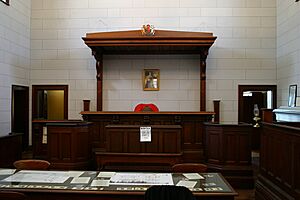
Traditionally, the monarch is known as the fount of justice. However, he does not personally rule in judicial cases, meaning that judicial functions are normally performed only in the monarch's name. In most jurisdictions, criminal offences are legally deemed to be offences against the sovereign and proceedings for indictable offences are brought in the sovereign's name in the form of The King [or Queen] against [Name] (typically shortened to R v [Name] standing for Rex for King or Regina for Queen). However, offences in Western Australia and Tasmania are brought in the name of the particular state. Civil lawsuits against the Crown in its public capacity (that is, lawsuits against the government) are permitted due to statute. In international cases, as a sovereign and under established principles of international law, the monarch of Australia is not subject to suit in foreign courts without his express consent. The prerogative of mercy lies with the monarch, and is exercised in the state jurisdictions by the governors.
States and territories
In accordance with the Australia Act 1986, the sovereign has the power to appoint, on advice tendered by the relevant state premier, a governor in each of the Australian states, who themselves appoint executive bodies, as well as people to fill casual Senate vacancies, if the relevant state parliament is not in session. The state governors continue to serve as the direct representatives of the monarch, in no way subordinate to the governor-general, and they carry out on his behalf all of the monarch's constitutional and ceremonial duties in respect of their respective state. The Northern Territory and the Australian Capital Territory resemble states in many respects, but are administered directly by the Commonwealth of Australia; an administrator, appointed by the governor-general upon the advice of the Commonwealth government, takes the place of a state governor in the Northern Territory. The Australian Capital Territory has no equivalent position.
Cultural role
Royal presence and duties
The sovereign and their family have participated in events such as various centennials and bicentennials; Australia Day; the openings of Olympic and other games; award ceremonies; D-Day commemorations; anniversaries of the monarch's accession; and the like.
Other royals have participated in ceremonies organised by or involving Australia and other Commonwealth nations abroad, such as Charles III, then Prince Charles, at the 2015 Anzac Day ceremonies at Gallipoli, the Duke of Edinburgh at the Anzac Day service in Hyde Park, London in 2024, or the Duke of Sussex's attendance at an Australia House reception for Australian athletes in the 2014 Invictus Games.
Members of the royal family have also made private donations to Australian charities or causes, such as when Elizabeth II made a private donation to the Australian Red Cross Appeal after the Blue Mountains bushfires in 2009 and Prince William to the Australian Red Cross during floods in 2023.
The Crown and the Australian Defence Force
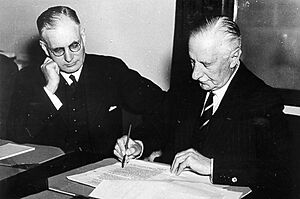
Section 68 of the Australian Constitution says: "The command in chief of the naval and military forces of the Commonwealth is vested in the governor-general as the Queen's [monarch's] representative." In practice, however, the governor-general does not play any part in the Australian Defence Force's command structure other than following the advice of the Minister for Defence in the normal form of executive government. All personnel of the Australian Defence Force swear an Oath of Allegiance (or affirmation) to the Australian Monarch where they pledge to "resist his (or her) enemies."
Australian naval vessels bear the prefix His Majesty's Australian Ship (HMAS) and many organisational groupings of the defence force (such as the Royal Australian Infantry Corps, Royal Australian Air Force and the Royal Australian Engineers) carry the "royal" prefix.
Members of the royal family have presided over military ceremonies, including Trooping the Colour ceremonies, inspections of the troops, and anniversaries of key battles. When Elizabeth II was in Canberra, she laid wreaths at the Australian War Memorial. In 2003, Elizabeth acted in her capacity as Australian monarch when she dedicated the Australian War Memorial in Hyde Park, London. In 2024, Charles III as part of his tour of Sydney and Canberra, laid wreaths at the Australian War Memorial, as well as presiding over a Royal Fleet Review of the Royal Australian Navy, in Sydney.
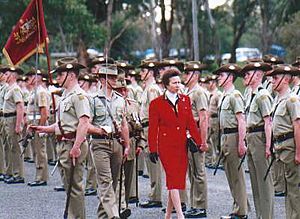
Monarchs of Australia (or their spouse in the case of Elizabeth II) are appointed to the highest ranks in each of the branches of the Defence Force. In 2024, Charles III was appointed to the Honorary Ranks of admiral of the fleet of the Royal Australian Navy, field marshal of the Australian Army, and marshal of the Royal Australian Air Force, by the governor-general of Australia. These ranks have always been held by members of the royal family, with the exceptions of field marshals Sir William Birdwood and Sir Thomas Blamey.
Additionally, some members of the royal family are Colonels-in-Chief of Australian regiments, including: the Royal Regiment of Australian Artillery; Royal Australian Army Medical Corps; the Royal Australian Armoured Corps and the Royal Australian Corps of Signals, amongst many others.
Australian royal symbols
Royal symbols are the visual and auditory identifiers of the Australian monarchy. The main symbol of the monarchy is the sovereign. The monarch's portrait has appeared on all Australian coins, with King Charles III's portrait in use for newly minted coins since 2024. The monarch's image also previously appeared on most Australian definitive stamps until 1973. Due to complaints by royalists about this change, the annual Queen's Birthday stamp was introduced in 1980. The monarch has also previously appeared on the lowest denomination of all Australian banknotes, with Queen Elizabeth II's portrait currently appearing on the five-dollar banknote. However the Reserve Bank has announced that this design will be replaced one that depicts Indigenous Australian culture and history instead of the new monarch.
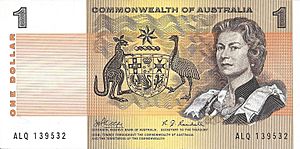
A crown is depicted on the Queensland and Victorian state badges (which are included on the Australian coat of arms,) and on various medals and awards. For example, the crown's presence on the insignia of the Order of Australia represents the monarch's role as Head of the Order. The sovereign is further both mentioned in and the subject of songs and loyal toasts. Australia inherited the royal anthem "God Save the King" (alternatively, "God Save the Queen" in the reign of a female monarch) from the United Kingdom. It was the national anthem of Australia until 1984, and has since been retained as the country's royal anthem, its use generally restricted to official occasions where the monarch or a member of the royal family is present.
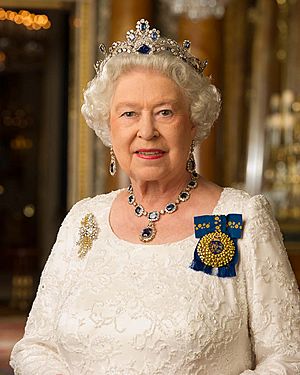
His Majesty The King's Flag for Australia, approved on 30 August 2024 by Charles III, signifies his presence and is displayed when Charles is in Australia. The flag was first used during the 2024 royal visit. The flag is used in the same way as the Royal Standard of the United Kingdom. Where practical, when it is flown on or outside a building, no other flag should be flown with it and is flown when the King is visiting Australia from all buildings, cars, boats or aircraft that he occupies. The flag features the six quarters of the Commonwealth Coat of Arms, surrounded by an ermine border which represents the federation.
As in other Commonwealth realms, the King's Official Birthday is a public holiday and, in Australia, is observed on the second Monday in June in all states and territories, except Queensland and Western Australia. In Queensland, it is celebrated on the first Monday in October, and in Western Australia it is usually the last Monday of September or the first Monday of October. Celebrations are mainly official, including the Australian Birthday Honours list and military ceremonies.
Popular royal symbolism emerged during the reign of Queen Victoria, as a means of encouraging loyalty to the wider British Empire. The continued presence of royal symbols has been argued to act as a "social construction of reality", which reinforces their perception as a "positive role in national life". Such symbolism has been criticised as akin to propaganda, that acts to counter arguments against the royals' social and political power.
Religious role
Until its new constitution went into force in 1962, the Anglican Church of Australia was part of the Church of England. Its titular head was consequently the monarch, in his or her capacity as Supreme Governor of the Church of England. However, unlike in England, Anglicanism was never established as a state religion in Australia.
History
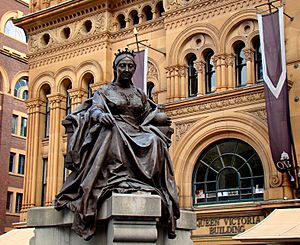
The development of the Australian monarchy into the independent entity it is today began in 1770, when Captain James Cook, in the name of, and under instruction from, King George III, claimed the east coast of Australia. Colonies were eventually founded across the continent, all of them ruled by the monarch of the United Kingdom, upon the advice of his or her British ministers, the Secretary of State for the Colonies, in particular. In 1901 the six colonies united to form the Commonwealth of Australia, following the assent of Queen Victoria to the Commonwealth of Australia Constitution Act. However, this did not change the relationship of the monarch to the new nation, with her powers (such as the appoint of governors, governors-general and others set out in the Constitution) exercised in accordance with the advice of British ministers.
This situation continued until after the First World War, where in response to calls from some Dominions for a re-evaluation of their status under the Crown after their sacrifice and performance in the conflict, the Balfour Declaration of 1926 was issued following a series of Imperial conferences. The statement provided that the United Kingdom and the Dominions were to be "autonomous communities within the British Empire, equal in status, in no way subordinate to one another in any aspect of their domestic or external affairs, though united by a common allegiance to the Crown". The Royal and Parliamentary Titles Act 1927, an Act of the Westminster Parliament, was the first indication of a shift in the law, which ensured the independence of the office. Another move to independence occurred in 1930, when the British government agreed that the Australian Cabinet would advise the sovereign directly on the choice of governor-general. The Crown was further separated by the Statute of Westminster 1931, adopted by Australia in 1942 (retroactive to 3 September 1939).
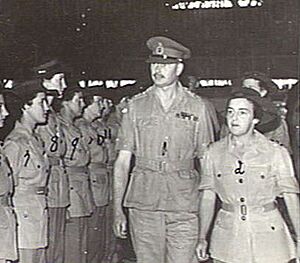
The Curtin Labor government appointed Prince Henry, Duke of Gloucester, as governor-general during the Second World War. Curtin hoped the appointment might influence the British to despatch men and equipment to the Pacific War, and the selection of the brother of King George VI reaffirmed the important role of the Crown to the Australian nation at that time. Queen Elizabeth II became the first reigning monarch to visit Australia in 1954, greeted by huge crowds across the nation. In 1967, Elizabeth's son, Charles III (then Prince Charles), attended school in Geelong Grammar School in Corio, Victoria. Her grandson Prince Harry undertook a portion of his gap-year living and working in Australia in 2003.

The sovereign did not possess a title unique to Australia until the Australian Parliament enacted the Royal Styles and Titles Act in 1953, after the accession of Elizabeth to the throne, and giving her the title of Queen of the United Kingdom, Australia and Her other Realms and Territories. However, Elizabeth only acted as Queen of Australia at the federal level. At the state level, Elizabeth acted as Queen of the United Kingdom with state laws still subject to the Colonial Laws Validity Act, which meant that UK laws overrode them when inconsistent. While the federal government adopted the Statute of Westminster in 1942, which removed the legislative restrictions of the Colonial Laws Validity Act, the states specifically asked to be excluded from the agreement. This was because they felt their interests were better protected whilst they were under the authority of the UK, which provided a buffer against the increasing power of the federal government.
Thus, the British government could still – at least in theory, if not with some difficulty in practice – legislate for the Australian states, and the governors in the states were appointed by and represented the sovereign of the United Kingdom, not that of Australia. As late as 1976, the British ministry advised the monarch to refuse Colin Hannah another term as Queensland's governor, after seriously considering unilaterally dismissing him due his breach of political impartiality, despite the recommendation of the then state Bjelke-Petersen government for his nomination. Additionally, court cases from state supreme courts could be appealed directly to the Judicial Committee of the Privy Council in London, thereby bypassing the Australian High Court which otherwise could not be appealed in the privy council for federal matters since 1968 and for state matters since 1975. In 1973 reference to the United Kingdom was removed by the Royal Style and Titles Act. Henceforth, the monarch would be styled uniquely as Queen of Australia. Elizabeth signed her assent to the Act at Government House, Canberra that year, leading Senior Vice President of the Labor Party, Jack Egerton, to remark to her, "They tell me, love, you've been naturalised." It was with the passage of the Australia Act 1986, which repealed the Colonial Laws Validity Act and abolished appeals of state cases to London, that the final vestiges of the British monarchy in Australia were removed, leaving a distinct Australian monarchy for the nation. The view in the Republic Advisory Committee's report in 1993 was that if, in 1901, Victoria, as Queen-Empress, symbolised the British Empire of which all Australians were subjects, all of the powers vested in the monarch under Australia's Constitution were now exercised on the advice of the Australian government.
The 1999 Australian republic referendum was defeated by 54.4 per cent of the populace, despite polls showing that the majority supported becoming a republic. Many commentators have argued that disagreement between republicans as to the preferred model for a republic (most notably over whether the president should be appointed or directly elected) was a key factor in the "no" result. The referendum followed the recommendation of a 1998 Constitutional Convention called to discuss the issue of Australia becoming a republic. The Queen visited Australia a year after the referendum and stated that "I respect and accept the outcome of the referendum. In the light of the result last November, I shall continue faithfully to serve as Queen of Australia under the Constitution to the very best of my ability".
Elizabeth II, the longest-serving monarch, died on 8 September 2022, and was succeeded by her son, Charles III. The coronation of Charles III and Camilla took place on 6 May 2023. In October 2024, Charles III became the first reigning King of Australia to visit the country.
Debate
Public polling
Various polls have been conducted on public support for the monarchy since at least 1953. These have produced a variety of responses, depending on the specific framing of the question. A peer review analysis of survey data published in the Australian Journal of Political Science in 1993 found that republican sentiment had slowly and stably increased from the 1950s and rose rapidly in the late 1980s and early 1990s such that certain polls indicated a majority or plurality republican support. A follow up analysis published in 2016 found that support for the monarchy reached a low of 34 per cent in 1998 following the 1992 annus horribilis, before rising significantly to around 50% by 2016.
Following the accession of King Charles in September 2022, the number of polls on the republic issue increased, producing a range of responses.
Political debate
Whereas prime minister Julia Gillard stated that she would like to see Australia become a republic, she, on 21 October 2011, at a reception in the presence of the Queen at Parliament House, asserted that the monarch is "a vital constitutional part of Australian democracy and would only ever be welcomed as a beloved and respected friend". After Kevin Rudd was appointed as prime minister, he affirmed that a republic was still a part of his party's platform and stated his belief that the debate on constitutional change should continue.
Gillard had, during her time as prime minister, propounded that an appropriate time for Australia to become a republic would be after the end of the reign of Queen Elizabeth II. Following Elizabeth's death, the Prime Minister, Anthony Albanese, said in an interview he wanted Australia to have an appointed head of state, but he did not have a timetable for a referendum, did not commit to advising one take place during his time as prime minister, and postulated that no vote should happen until demand rose from the grassroots. Albanese had earlier stated he would, out of respect for Elizabeth, merely refrain from having the governor-general call a referendum before the next election for the House of Representatives.
Republicans have dismissed the large public turnouts during royal tours as "the cult of celebrity". However, following Prince William's and Catherine's visit to the Blue Mountains after devastating bush fires in 2014, historian Jane Connors opined that "there is still a sense that having the royal family come to see you is more healing and significant than just having anyone come to see you", citing comments made by some who had come to the area while the royal couple were present. Academic Holly Randell-Moon has criticised royal visits as reinforcing the legitimacy of white settler possession against Indigenous sovereignty, with celebrity responses to the royals "obscuring the racial and religious power" of monarchy.
Ex-governor-general Michael Jeffery has also argued that the constitutional monarchy has been key to Australia's political stability and lack of civil wars.
The idea of a uniquely Australian monarch, resident in Australia, has been voiced occasionally. The proposition was first published in 1867. It was later reiterated by Alan Atkinson in his 1993 book The Muddle Headed Republic, by Harry Meklonian in 2009, and by Richard Hughes in 2017. In a similar vein, Waleed Aly suggested in 2022 replacing the monarch with a life appointed Indigenous "First Elder". Another possibility, offered in 2009 by an American constitutional lawyer, would be to crown someone in the line of succession to the Australian throne (such as Prince Andrew and Prince Harry), but who is not expected to become monarch by the present rules of succession.
List of monarchs of Australia
Colonial period (1770–1901)
| Portrait | Regnal name (Birth–Death) Royal dynasty |
Reign over Australia | Full name | Consort | |
|---|---|---|---|---|---|
| Start | End | ||||
 |
George III (1738–1820) House of Hanover |
29 April 1770 | 29 January 1820 | George William Frederick | Charlotte of Mecklenburg-Strelitz |
| Governors of New South Wales: Arthur Phillip, John Hunter, Philip King, William Bligh, Lachlan Macquarie | |||||
 |
George IV (1762–1830) House of Hanover |
29 January 1820 | 26 June 1830 | George Augustus Frederick | Caroline of Brunswick |
| Governors of New South Wales: Sir Thomas Brisbane, Sir Ralph Darling | |||||
| Governor of Western Australia: Sir James Stirling | |||||
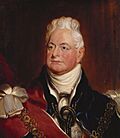 |
William IV (1765–1837) House of Hanover |
26 June 1830 | 20 June 1837 | William Henry | Adelaide of Saxe-Meiningen |
| Governor of New South Wales: Sir Richard Bourke | |||||
| Governor of Western Australia: Sir James Stirling | |||||
| Governor of South Australia: Sir John Hindmarsh | |||||
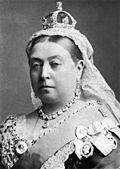 |
Victoria (1819–1901) House of Hanover |
20 June 1837 | 1 January 1901 | Alexandrina Victoria | Albert of Saxe-Coburg and Gotha |
| Governors of New South Wales: Sir George Gipps, Sir Charles FitzRoy, Sir William Denison, Sir John Young, Somerset Lowry-Corry, 4th Earl Belmore, Sir Hercules Robinson, Lord Augustus Loftus, Charles Wynn-Carington, 3rd Baron Carrington, Victor Child Villiers, 7th Earl of Jersey, Sir Robert Duff, Henry Brand, 2nd Viscount Hampden, William Lygon, 7th Earl Beauchamp | |||||
| Governors of Western Australia: Sir James Stirling, John Hutt, Sir Andrew Clarke, Charles Fitzgerald, Sir Arthur Kennedy, John Hampton, Sir Benjamin Pine, Sir Frederick Weld, Sir William Robinson, Sir Harry Ord, Sir Frederick Broome, Sir Gerard Smith | |||||
| Governors of South Australia: George Gawler, Sir George Grey, Frederick Robe, Sir Henry Young, Sir Richard MacDonnell, Sir Dominick Daly, Sir James Fergusson, Sir Anthony Musgrave, Sir William Jervois, Sir William Robinson, Algernon Keith-Falconer, 9th Earl of Kintore, Sir Thomas Buxton, Hallam Tennyson, 2nd Baron Tennyson | |||||
| Governors of Victoria: Sir Charles Hotham, Sir Henry Barkly, Sir Charles Darling, John Manners-Sutton, 3rd Viscount Canterbury, Sir Sir George Bowen, George Phipps, 2nd Marquess of Normanby, Sir Henry Loch, John Hope, 7th Earl of Hopetoun, Thomas Brassey, 1st Earl Brassey | |||||
| Governors of Tasmania: Sir Henry Young, Sir Thomas Browne, Sir Charles Du Cane, Sir Frederick Weld, Sir John Lefroy, Sir George Strahan, Sir Robert Hamilton, Jenico Preston, 14th Viscount Gormanston | |||||
| Governors of Queensland: Sir George Bowen, Samuel Blackall, George Phipps, 2nd Marquess of Normanby, Sir William Cairns, Sir Arthur Kennedy, Sir Anthony Musgrave, Sir Henry Norman, Charles Cochrane-Baillie, 2nd Baron Lamington | |||||
Federation (1901–present)
British Crown (1901–1939)
| Portrait | Regnal name (Birth–Death) Royal dynasty |
Reign | Full name | Consort | |
|---|---|---|---|---|---|
| Start | End | ||||
 |
Victoria (1819–1901) House of Hanover |
1 January 1901 | 22 January 1901 | Alexandrina Victoria | Widowed |
| Governor-general: John Hope, 7th Earl of Hopetoun | |||||
| Prime minister: Edmund Barton | |||||
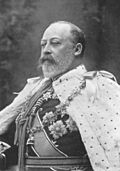 |
Edward VII (1841–1910) House of Saxe-Coburg and Gotha |
22 January 1901 | 6 May 1910 | Albert Edward | Alexandra of Denmark |
| Governors-general: John Hope, 7th Earl of Hopetoun, Hallam Tennyson, 2nd Baron Tennyson, Henry Northcote, 1st Baron Northcote, William Ward, 2nd Earl of Dudley | |||||
| Prime ministers: Edmund Barton, Alfred Deakin, Chris Watson, George Reid, Alfred Deakin, Andrew Fisher, Alfred Deakin | |||||
 |
George V (1865–1936) House of Saxe-Coburg and Gotha (until 1917) House of Windsor (after 1917) |
6 May 1910 | 20 January 1936 | George Frederick Ernest Albert | Mary of Teck |
| Governors-general: William Ward, 2nd Earl of Dudley, Thomas Denman, 3rd Baron Denman, Sir Ronald Ferguson, Henry Forster, 1st Baron Forster, John Baird, 1st Baron Stonehaven, Sir Isaac Isaacs | |||||
| Prime ministers: Andrew Fisher, Joseph Cook, Andrew Fisher, Billy Hughes, Stanley Bruce, James Scullin, Joseph Lyons | |||||
 |
Edward VIII (1894–1972) House of Windsor |
20 January 1936 | 11 December 1936 | Edward Albert Christian George Andrew Patrick David | None |
| Governors-general: Sir Isaac Alfred Isaacs, Alexander Hore-Ruthven, 1st Earl of Gowrie | |||||
| Prime minister: Joseph Lyons | |||||
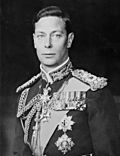 |
George VI (1895–1952) House of Windsor |
11 December 1936 | 3 September 1939 | Albert Frederick Arthur George | Elizabeth Bowes-Lyon |
| Governors-general: Alexander Hore-Ruthven, 1st Earl of Gowrie | |||||
| Prime ministers: Joseph Lyons, Sir Earle Page, Robert Menzies | |||||
Australian Crown (1939–present)
The date of separation of the Australian Crown from the British Crown is a matter of debate (see emergence of a separate Crown above), however the process most likely occurred in the 1930s to 1940s, and was complete by at least 1948.
| Portrait | Regnal name (Birth–Death) Royal dynasty |
Reign | Full name | Consort | |
|---|---|---|---|---|---|
| Start | End | ||||
 |
George VI (1895–1952) House of Windsor |
3 September 1939 | 6 February 1952 | Albert Frederick Arthur George | Elizabeth Bowes-Lyon |
| Governors-general: Alexander Hore-Ruthven, 1st Earl of Gowrie, Prince Henry, Duke of Gloucester, Sir William McKell | |||||
| Prime ministers: Robert Menzies, Arthur Fadden, John Curtin, Frank Forde, Ben Chifley, Robert Menzies | |||||
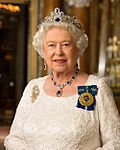 |
Elizabeth II (1926–2022) House of Windsor |
6 February 1952 | 8 September 2022 | Elizabeth Alexandra Mary | Philip Mountbatten |
| Governors-general: Sir William McKell, Sir William Slim, William Morrison, 1st Viscount Dunrossil, William Sidney, 1st Viscount De L'Isle, Richard Casey, Baron Casey, Sir Paul Hasluck, Sir John Kerr, Sir Zelman Cowen, Sir Ninian Stephen, William Hayden, Sir William Deane, Peter Hollingworth, Michael Jeffery, Dame Quentin Bryce, Sir Peter Cosgrove, David Hurley | |||||
| Prime ministers: Sir Robert Menzies, Harold Holt, John McEwen, John Gorton, William McMahon, Gough Whitlam, Malcolm Fraser, Bob Hawke, Paul Keating, John Howard, Kevin Rudd, Julia Gillard, Kevin Rudd, Tony Abbott, Malcolm Turnbull, Scott Morrison, Anthony Albanese | |||||
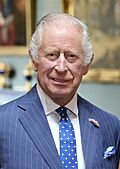 |
Charles III (born 1948) House of Windsor |
8 September 2022 | Present | Charles Philip Arthur George | Camilla Shand |
| Governors-general: David Hurley, Samantha Mostyn | |||||
| Prime ministers: Anthony Albanese | |||||
Timeline of monarchs since Federation

See also
 In Spanish: Monarquía en Australia para niños
In Spanish: Monarquía en Australia para niños
- Australian State Coach
- List of Australian organisations with royal patronage
- Royal tours of Australia
- List of Commonwealth visits made by Elizabeth II
- List of prime ministers of Elizabeth II
- List of sovereign states headed by Elizabeth II
- Australian peers and baronets
- Wattle Queen
- King-in-Parliament


